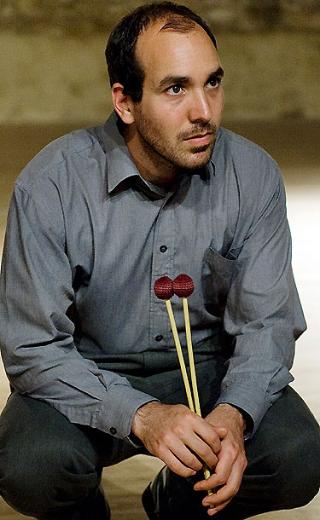Analysing the psychophysical actor
Mon, 23 Jul 2012 15:48:00 BST
PhD researcher’s investigation of ‘Rhythm’ in psychophysical actor training

WORKING as a closely-knit team, their every gesture and movement filled with meaning, actors and performers can reach heights of expression on stage. Research by a University of Huddersfield PhD student is finding out how this can be achieved by individuals and ensembles. And the answer lies in rhythm.
Eilon Morris, aged 33, was born in Israel and raised in Melbourne, Australia. After he heard of the University’s reputation for theatre studies, he came to Huddersfield in 2007 to research first for a Masters and now for a Doctorate in aspects of ‘psychophysical theatre’. The PhD thesis – on the verge of completion – is entitled ‘An Investigation of Rhythm in Psychophysical Actor Training’.
Psychophysical actor training can be traced back to legendary Russian actor and director Stanislavski (1863-1938) who developed a rigorous new method of actor training based on the relationship between thought processes and physical action. Now Eilon has made his own contribution to this field and in addition to writing and researching he has worked with a number of international theatre companies and studied innovative performance practice around the world.
Working with professional actors as well as drama students at undergraduate and postgraduate level, he has taught at places such as London’s Central School of Speech and Drama and studied himself in Cuba, Israel and Mexico. As a performer, he has acted with companies in Australia, France and the UK.
As a practitioner, Eilon is very much involved in making, directing and performing which contrasts which his research where he feels his main role is to provide actors with the physical and emotional equipment they need.
“I am looking at pre-expressive level of training,” he explains. “It is not to do with an aesthetic or a performance style but deals with basic elements such as attention, the connection of an ensemble, levels of energy and qualities of listening – the basic principles that you can apply to any style, the mechanisms that actors need in order to be present and engaged.”
Eilon approaches these elements through rhythm.
He starts with basic patterns such as walking rhythms and then adds physical gestures and vocal rhythms. The aim is to show how “an underlying sense of ensemble is connected to a rhythm and based on a deeper quality of listening”.
Eilon’s wide-ranging research into historical and current practices has led him to devise his own system, which he has named ‘Orbits’.
“I am taking different rhythmical choreographies and placing them in the space, so you have different circles performing in different rhythms simultaneously.
“It might actually be quite interesting to watch, but it is intentionally non-performative. The actors aren’t thinking about presentation but about how they connect to each other.”







